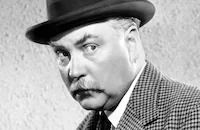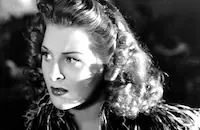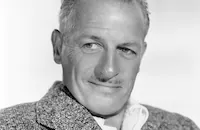Sherlock Holmes and the Voice of Terror
Brief Synopsis
Cast & Crew
John Rawlins
Basil Rathbone
Nigel Bruce
Evelyn Ankers
Reginald Denny
Thomas Gomez
Film Details
Technical Specs

Synopsis
London is plagued for months by the German radio broadcast "The Voice of Terror," which taunts the people of England with tales of German sabotage. Sir Evan Barham of the British Intelligence Inner Council calls upon famed private detective Sherlock Holmes and his associate, Dr. Watson, to help uncover the sabotage ring. Holmes tells the council that he believes that the German broadcasts are merely a "smoke-screen" for something bigger. That night, Gavin, one of Holmes's operatives, stumbles into the detective's flat, fatally wounded with a German dagger in his back. Before he dies, though, Gavin utters the word "Christopher." Later, Holmes and Watson go to the Limehouse district of London, where they meet with Gavin's wife Kitty. Learning that her husband was killed by Nazi spies, Kitty convinces her friends to search all of London to find the meaning of "Christopher." The next day, Holmes and Watson return to the council's office and learn that Sir Evan was almost killed by an assassin's bullet. Holmes tells the council that he has determined that "The Voice of Terror" is actually recorded on phonograph records in England, but broadcast from Germany. Using a tip from Kitty, Holmes and Watson go to the old Christopher Docks, where they are followed by Sir Anthony Lloyd of the council. There, the three men are captured by a group of Nazi spies led by a man named Meade. They are saved, however, by Kitty's friends, but Meade manages to escape through a trap door to a waiting speedboat. Later, pretending to be a common thief, Kitty manages to ingratiate herself with Meade. Meanwhile, Holmes tells Watson that he believes there is a spy on the council, and Kitty later tells them that Meade plans to go to Sir Evan's country estate that night. While Meade hides in the dark, Holmes and Sir Evan watch a German plane attempt to land, but gunshots fired by Sir Evan disrupt the Nazi rendezvous. Later, "The Voice of Terror" announces that there will be a German aerial attack on the northeast coast of England. Sir Evan insists that the British defenses be moved to that area, but Holmes warns the council that the broadcast could be a bluff, as the "Voice" always broadcasts during an German attack, not before one. After one of his operatives traces Meade and Kitty to the south coast of England, Holmes forces the council to go there with him. With the support of British troopers, Holmes captures Meade and a group of German soldiers stationed in an abandoned church. Holmes then tells the stunned gathering that Sir Evan is "The Voice of Terror," and is actually a German spy named Heinrich von Bork who has been posing as Sir Evan for twenty years, as the real Sir Evan was executed as a prisoner of war during World War I. Holmes then informs the spies that the German invasion force has been destroyed. The angry Meade shoots and fatally wounds Kitty, but is killed himself as he attempts to escape. The British gentlemen then stand around the murdered Kitty and swear that her heroic death will not be in vain.

Director
John Rawlins
Cast

Basil Rathbone

Nigel Bruce

Evelyn Ankers

Reginald Denny

Thomas Gomez

Henry Daniell

Montagu Love
Olaf Hytten
Leyland Hodgson
Arthur Blake
Harry Stubbs
Mary Gordon
Davis Roberts
Donald Stuart
Leslie Denison
Robert Barron
Alec Harford
John Rogers

Harry Cording
Herbert Evans
John Wilde
Arthur Stenning
George Sherwood

Hillary Brooke
Charles Jordan
Crew
Robert D. Andrews
Ludwig Van Beethoven
Howard Benedict
Woody Bredell
John Bright
Bernard B. Brown
R. A. Gausman
Joseph Mcdonough
Tom Mcknight
Martin Obzina
Jack Otterson
Charles Previn
Robert Pritchard
Lynn Riggs
Edward R. Robinson
Russell Schoengarth
Frank Skinner
Vera West

Film Details
Technical Specs

Articles
Sherlock Holmes and the Voice of Terror
Opening title card for Sherlock Holmes and the Voice of Terror
Literature's greatest sleuth leapt into a modern world of Axis spies, radio propaganda and aerial warfare when Universal Pictures launched their 12-film series of Sherlock Holmes films with the 1942 thriller Sherlock Holmes and the Voice of Terror. Although B pictures designed to fill out the lower half of a double bill, the Holmes series was first-class all the way, particularly in the performance of Basil Rathbone, who even six decades later remains the actor most associated with the role.
Rathbone had starred, with Nigel Bruce as Dr. Watson, in two very popular 1939 films from 20th Century-Fox, The Hound of the Baskervilles and The Adventures of Sherlock Holmes. Both of those had been lavish productions set, like Sir Arthur Conan Doyle's stories, in the late 19th century. With the outbreak of World War II, however, Fox executives decided the character was too quaint for an era of modern warfare. Though Fox chose not to continue the series, Rathbone, Bruce and Mary Gordon -- who had played their landlady, Mrs. Hudson -- continued playing their roles on the radio.
Universal was no stranger to updating classic characters and had scored at the box office by transporting the Frankenstein monster and Dracula into the modern era. The studio had been close to bankruptcy in the '30s, saved by a new series of horror films -- including the 1939 Son of Frankenstein, with Rathbone in the title role -- and the discovery of Deanna Durbin and Abbott and Costello. By the early '40s, the revitalized studio was trying to build up its B movie slate to provide support for its major films. They struck a deal with the Doyle estate for the rights to 21 of the stories over a seven-year period. As the Holmes series was assigned to the studio's B movie unit, Universal naturally decided to update them to avoid the cost of period sets and costumes. In addition, with Rathbone's and Bruce's continuing popularity on radio, they naturally turned to them to re-create the roles, signing Gordon as well.
Although Universal never made a true adaptation of any of the stories, they borrowed plot elements for all of them. For Sherlock Holmes and the Voice of Terror, they drew primarily on "His Last Bow," a 1917 story pitting Holmes against a German spy on the eve of World War I. Although the idea of Holmes helping the British government track down a spy -- and even the spy's name, von Bork -- were retained, most of the story was original, with the detective this time enlisted at the height of the war to help track down "The Voice of Terror," a German agent posing as a British noble in taunting radio broadcasts designed to break British morale. That plot twist was inspired by the activities of "Lord Haw-Haw," who actually was several different Nazi agents who, like Axis Sally and Tokyo Rose, hosted a radio show sending Axis propaganda to the Allies.
Before the film's release, there was concern among Holmes' many fans that updating the sleuth would constitute a betrayal of the character. Writing in the Hollywood Citizen News, Frederick C. Othman predicted, "These movie makers just seem to be going out of their way for trouble....good old Sherlock and Dr. Watson will probably have to go into hiding..." In an attempt to forestall objections, Universal hired one of the world's leading authorities on Holmesiana, Thomas McKnight, as technical director. They also took pains to feature Holmes' violin and magnifying glass in the films, although the character's traditional deerstalker cap was deemed too out of date. In Sherlock Holmes and the Voice of Terror, the writers even included a brief moment in which Holmes is about to grab his trademarked hat, only to be stopped by Watson, who encourages him to wear a more modern fedora instead.
Whatever the doubts of Holmes' fans, the film proved highly popular, most often paired on double bills with Abbott and Costello's Pardon My Sarong (1942). Most critics praised Sherlock Holmes and the Voice of Terror for maintaining the spirit of the original, even in the midst of modernization, with The Hollywood Reporter suggesting "The Baker Street Irregulars [the Sherlock Holmes fan club] should admit to membership Lynn Riggs and Robert D. Andrews [the screenwriters] for the care with which Holmes is brought up to date without sacrifice for his methods of deduction that capture the imagination..." The New York Times' Bosley Crowther was among the few dissenters, writing, "It is surprising that Universal should take such cheap advantage of the present crisis to exploit an old, respected fiction character.... The late Conan Doyle, who obviously never wrote this story, as Universal claims, must be speculating sadly in his spirit world on this betrayal of trust." Wartime censorship kept the film out of Great Britain until 1943.
The film's success led Universal to follow it with 13 more low-budget features, most of them shot on standing sets, incorporating footage from earlier films (the train crash in Sherlock Holmes and the Voice of Terror was lifted from 1933's The Invisible Man) and scored with stock music. Holmes, Watson and Gordon were essential parts of the series, while supporting players Henry Daniell and Hillary Brooke would return in two more films as different characters. Leading lady Evelyn Ankers, a veteran of Universal's horror films, would also return to the series as mistress of disguise Naomi Drake in The Pearl of Death (1944).
Producer: Howard Benedict
Director: John Rawlins
Screenplay: Robert D. Andrews, Lynn Riggs, John Bright
Based on the story "His Last Bow" by Arthur Conan Doyle
Cinematography: Elwood Bredell
Art Direction: Jack Otterson
Music: Charles Previn, Richard Hageman
Cast: Basil Rathbone (Sherlock Holmes), Nigel Bruce (Doctor Watson), Evelyn Ankers (Kitty), Reginald Denny (Sir Evan Barham), Thomas Gomez (Meade), Henry Daniell (Alfred Lloyd), Montagu Love (Gen. Jerome Lawford), Edgar Barrier (Voice of Terror), Hillary Brooke (Jill Grandis), Mary Gordon (Mrs. Hudson), Gavin Muir (BBC Radio Announcer).
BW-65m.
by Frank Miller
SOURCES:
Ron Haydock, Deerstalker! Holmes and Watson on Screen

Sherlock Holmes and the Voice of Terror
Quotes
Trivia
The scene in which a train goes off the tracks early in the film is footage from Universal's The Invisible Man (1933).
Notes
The working title of this film was Sherlock Holmes Saves London. The film begins with the following written prologue: "SHERLOCK HOLMES, the immortal character of fiction created by Sir Arthur Conan Doyle, is ageless, invincible and unchanging. In solving significant problems of the present day he remains-as ever-the supreme master of deductive reasoning." The Sir Arthur Conan Doyle short story from which this film is based was first published in the United States in Collier's Weekly (22 September 1917) and is also found in the collection His Last Bow (London, 1917). Sherlock Holmes and the Voice of Terror was the first in a series of Sherlock Holmes movies made by Universal in the 1940s, all starring Basil Rathbone and Nigel Bruce.
According to Hollywood Reporter, in March 1942, Universal paid $300,000 for a seven-year lease on the film rights to twenty-one Sherlock Holmes stories controlled by the Doyle estate. This agreement specifically excluded the four Sherlock Holmes novels, and did not include radio or stage rights to the short stories. For the Universal series, "Holmes" and "Watson" were transplanted from Victorian England to the twentieth century. Made during the war years, the Universal pictures had the famed detective and his physician companion fighting the Axis powers, as well as master criminal minds. Sherlock Holmes and the Voice of Terror was the only film in this series not directed by Roy William Neill. In all, twelve Sherlock Holmes films were made for the Universal series, which ended in 1946 with Dressed to Kill (see entry above).
Hollywood Reporter reported that writer Bob Jackson was originally assigned to write the screenplay for this production, but his contribution to the released film has not been determined. Early production charts include Marjorie Lord in the cast, but she did not appear in the film. Modern sources state that Lord was replaced in the role of Holmes's chauffeur "Jill Grandis" by Hillary Brooke. Modern sources also identify Universal character actor Edgar Barrier as the offscreen radio voice of "The Voice of Terror." For additional information on the series and other films featuring the Arthur Conan Doyle characters, including the two Rathbone-Bruce films made at Twentieth Century-Fox prior to the Universal series, consult the Series Index and see the entries for Sherlock Holmes and The Hound of the Baskervilles in the AFI Catalog of Feature Films, 1931-40 (F3.4020 and F3.2009).














